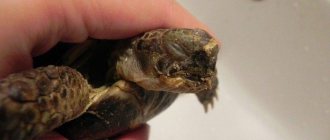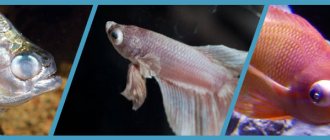Amphibians are in high demand. They are often bred at home for breeding, given to children, or simply bred as a hobby so that there is someone to take care of. Despite the fact that turtles are unpretentious animals and do not require special care, it is still necessary to closely monitor their health. Turtles are especially susceptible to eye diseases. Often, pathogenic bacteria penetrate into them, which can cause severe infections, inflammation and other unpleasant symptoms.
What is important to consider
First of all, make sure that the pet is simply not sleeping, because the good vision of the red-eared turtle allows it to stay awake both during the day and at night. Observe her throughout the day. Too much sleep and general lethargy can be warning signs of illness, even if the reptile's eyes are still shiny and wide open. In this case, immediately adjust the conditions of detention. So, the disease can be provoked by:
- Low water temperature;
- Lack or insufficient use of UV lamps and shore heating;
- Unbalanced diet;
- Poor filtration and irregular bottom cleaning.
If, after all the conditions have been corrected, the red-eared turtle does not open its eyes within 6 hours, sound the alarm. This means that the disease already exists. It remains to be found out what kind of illness struck the pet. To do this, observe the ward for another day. By the way, during this time be sure to stock up on:
- Container for quarantine;
- Pharmaceutical chamomile;
- Methylene blue;
- With cotton swabs.
Other medications may also be needed, but this will be discussed later - when the cause of the problem is found out. Let's start with the most common eye diseases of reptiles in aquaterrariums.
Uveitis and panophthalmitis
These conditions are characterized by inflammatory processes that can involve various tissues of the eye.
With uveitis, the disease affects the anterior chamber of the uveal tract, and with panophthalmitis, it affects all the membranes of the optic organ. Disturbances develop as a complication of septic pneumonia or as a result of sudden hypothermia. It can also be caused by pathogenic bacteria that have penetrated from the oral cavity into the subcorneal space through the lacrimal canal. With uveitis, the eye remains intact, but pus accumulates under the eyelids. As a rule, inflammation develops bilaterally. In addition, the condition may be accompanied by loss of appetite, exhaustion, rhinitis and lethargy.
Photo: vet.ru
Panophthalmitis manifests itself as a sharp swelling of the eyelids and thickening of the tissues of the visual organ. The turtle's eye becomes like a dense granule filled with pus, with cloudiness in the center.
Treatment of these diseases is carried out surgically, and eye rinsing and antibiotics are also indicated. The selection of drugs and treatment regimen are determined on an individual basis.
Common conjunctivitis
A sure sign of this sore is inflammation of one eye. If the disease starts, both will swell and close, and the mucous membranes will turn dark red. A red-eared turtle can “catch” this eye disease due to insufficient clean water. For treatment you will need:
- Place the turtle in any dry container and completely disinfect the aquaterrarium.
- Wash your pet with warm running water and pat dry thoroughly but gently with a simple cotton or linen towel.
- In the morning, at lunch and in the evening, drip sodium sulfacyl (aka albucid) into the eyes; in severe cases, a special tetracycline ointment in a small tube will not hurt.
Main symptoms of eye diseases
Eye diseases in turtles have different etiopathogenesis and, accordingly, are characterized by different symptoms and clinical manifestations.
The main symptoms of eye diseases in red-eared turtles:
- swelling, edema, sticking of the eyelids;
- redness of the mucous membrane;
- cloudy cornea, presence of a bluish film, white coating on the eyes;
- partial decrease in visual function, loss of vision;
- photophobia, blepharospasm;
- lacrimation;
- abundant mucous, catarrhal-serous, purulent discharge from the eyes;
- inadequate reaction of the pupil to light;
- corneal clouding;
- decreased activity, lethargy;
- deterioration of general condition.
The turtle's eyes are swollen.
Among other symptoms that indicate the development of ophthalmological diseases in pets, one can also note: weakness, decreased appetite, refusal of favorite treats, inappropriate behavior, lack of response to external stimuli. The turtle stretches its neck forward, takes unnatural poses, and rubs its sore eye with its paws. It hurts and stops opening.
The intensity of clinical manifestations depends on the root cause, the nature of the pathological process, and the stage of the disease.
Frequent pneumonia
If a red-eared turtle coughs, eats poorly, swims sideways, cannot dive and does not open its eyes, it is a 100% cold. The sore is not uncommon, unpleasant, but at the initial stage it is curable even at home. In this case, warm baths and inhalations with chamomile are effective. What does that require:
- Brew a strong decoction of a medicinal plant in a deep saucepan and inhale it as for a person. Your own nasopharynx will be an excellent indicator of temperature. As an option, a hand in which you can hold a suspended turtle is also suitable. The procedure will take at least 10 minutes, so if it’s hard to hold your hand suspended for so long, use a sieve, but not a metal colander. Otherwise, the pet will get burns.
- Upon completion of the inhalation, dilute the chamomile infusion with water to a temperature of 40-45ºC and give your client a bath. It is important that the temperature does not drop below 30ºС. It’s good if a sick pet splashes around in the healing infusion for at least 20-25 minutes.
- Then you need to warm the reptile for four hours in a dry container at a temperature not lower than 35ºC.
Such procedures need to be repeated a couple of times a day until the reptile recovers. Typically, the process takes about a week. But there are also more complex diseases that require a special approach.
Turtle cannot dive into water
The reptile has difficulty diving and drifts in an inclined position on the water surface. It is difficult for the turtle to stay under water or it cannot be there at all; mucus discharge appears from the nose and mouth. The cause is most often infectious diseases of the respiratory tract due to hypothermia.
Treatment:
- increase the temperature of water and air;
- increase air humidity. However, the air should not be stuffy;
- inhalation of chamomile vapor. The chamomile decoction is heated in the container so that the reptile located directly above it on the grate can inhale warm (up to +30-35 C) vapors.
Complex rhinitis
Many novice breeders often wonder what to do if a red-eared turtle sneezes, scratches its eyes, blows its nose, and at the same time has difficulty swimming. In this case, it won’t hurt to take a close look at the nostrils and inner corners of your pet’s eyes - they are inflamed with rhinitis. Further treatment depends on the causes of rhinitis:
- Polluted water. In this case, you cannot avoid a procedure that is unpleasant for the reptile and time-consuming for the owner - to rinse the turtle’s nasal passages with an antiseptic liquid using a syringe without a needle. A weak solution of furatsilin or chamomile at a comfortable temperature is suitable as an antiseptic.
- Another cause of a runny nose in a reptile may be improper feeding and, as a result, a lack of vitamin A. In this case, intramuscular injections of the vitamin or increased feeding with food containing it are recommended.
- Rhinitis and swelling of the eyes also occurs with hypothermia.
Causes of the disease
The main factors that can provoke the development of eye diseases include:
- lack of vitamins;
- the presence of a reptile in water with a low temperature, which can cause hypothermia of the entire body;
- lack of ultraviolet radiation;
- insufficient filtration;
- stagnant water;
- rare bottom cleaning.
In addition to the above reasons, other diseases can cause the disease.
Let's look at them. Familiarize yourself with the nuances of keeping such species of turtles as: Central Asian, vulture, caiman, fringed, marsh and trionics.
Conjunctivitis
The causative agents of this pathology are streptococci and staphylococci. Most often, the disease develops if the reptile is in dirty water. First, the inflammatory process begins in one eye, it begins to swell and close, it festers, the mucous membranes and eyelids become burgundy, the turtle constantly rubs the eye. If therapeutic measures are not taken in time, the disease will spread to the second one.
Blepharoconjunctivitis
The disease is caused by a lack of vitamin A or the presence of a bacterial infection in the body. The eyes also close, the eyelids become swollen and red, pus collects in the conjunctival sac, nasal discharge appears, the skin begins to peel, the body swells, and the reptile refuses to eat.
Uveitis
With this disease, the choroid becomes inflamed, as pathogenic bacteria penetrate into it. Purulent deposits begin to appear under the lower eyelid, and mucous discharge from the nose is noted. The reptile loses its appetite and severe exhaustion occurs.
You will probably be interested in reading about the lifestyle of a turtle, its life expectancy, and what to feed turtles.
Keratitis
It is characterized by the presence of inflammation in the cornea, which appears as a result of injury, burns, winter sleep or infections. There is redness of the conjunctiva and surrounding tissues, clouding of the cornea, increased tearing, swelling and enlargement of the eyelids, which significantly complicates the opening of the eyes. If the disease is traumatic in nature, then blood can be seen in the visual organ.
Optic neuropathy
The turtle has a constriction of the pupil, while the eyeball goes deeper inward, it becomes retracted, after which it loses mobility. In addition, it is heavily covered by the eyelid, as a result of which it does not open well.
Other signs are also present: clouding of the lens and vitreous body, disruption of the retinal structure, optic nerve atrophy. The disease can affect either one or two eyes at once. Leads to temporary or chronic vision loss.
Did you know? The heaviest are leatherback turtles - their weight can range from 300 to 500 kg.
Pneumonia
The most common cause of this disease is hypothermia. This causes coughing, whistling when breathing, shortness of breath, loss of appetite, and foamy discharge from the mouth and sinuses. In addition, there is difficulty in opening the eyes, the animal loses the ability to swim and the desire to dive.
The vitamin complex “Eleovit” will help replenish the reserves of essential substances in the turtle’s body.
Rhinitis
If this disease is present, the reptile cannot open its eyes; they constantly itch. Most of the time, the turtle is with its mouth open, from which mucus flows, and during breathing, bubbles appear and a squeak is heard.
Rickets
Lack of vitamin D leads to softening and deformation of the skeleton. The upper jaw may also become deformed, causing the animal to refuse food. If treatment is not started in a timely manner, redness appears in the eyes, they swell and eventually do not open.
Prevention
In order to prevent eye problems in your pet, you should adhere to the following recommendations:
- Inspect your turtle's eyes regularly;
- observe the coordination of the animal’s movement;
- change the water in the aquarium regularly;
- feed your reptile healthy food that contains vitamins and nutrients;
- Monitor the temperature of the water in the aquarium - it should not be cold.
To ensure that your pet is always healthy and makes you happy, pay attention to it and take care of its health. Unfortunately, animals often suffer from the same ailments as people and need timely treatment and care.
Nutrition of red-eared turtles for eye disease
In case of eye damage, it is very important to provide the turtle with proper nutrition. A turtle's diet should include foods rich in vitamin A. As far as we know, vitamin A is good for vision, and not just for turtles. Carrots are rich in this vitamin. The basis of the turtle's food is seafood, but if there is an eye disease, you can give it livers once a week, and also focus on food of plant origin, such as cabbage, seaweed, lettuce, and seaweed. As a rule, such foods are rich in vitamins.
If your pet is seriously ill and cannot open its eyes, it will be difficult for him to find food in the aquarium. In this case, the owner himself will need to feed the animal, otherwise it may die of starvation.
If there are other animals near the sick turtle, then it is better to isolate the sick turtle so that the disease does not harm its relatives.











